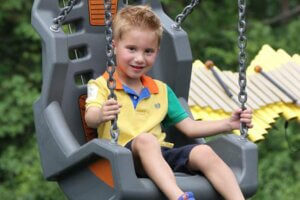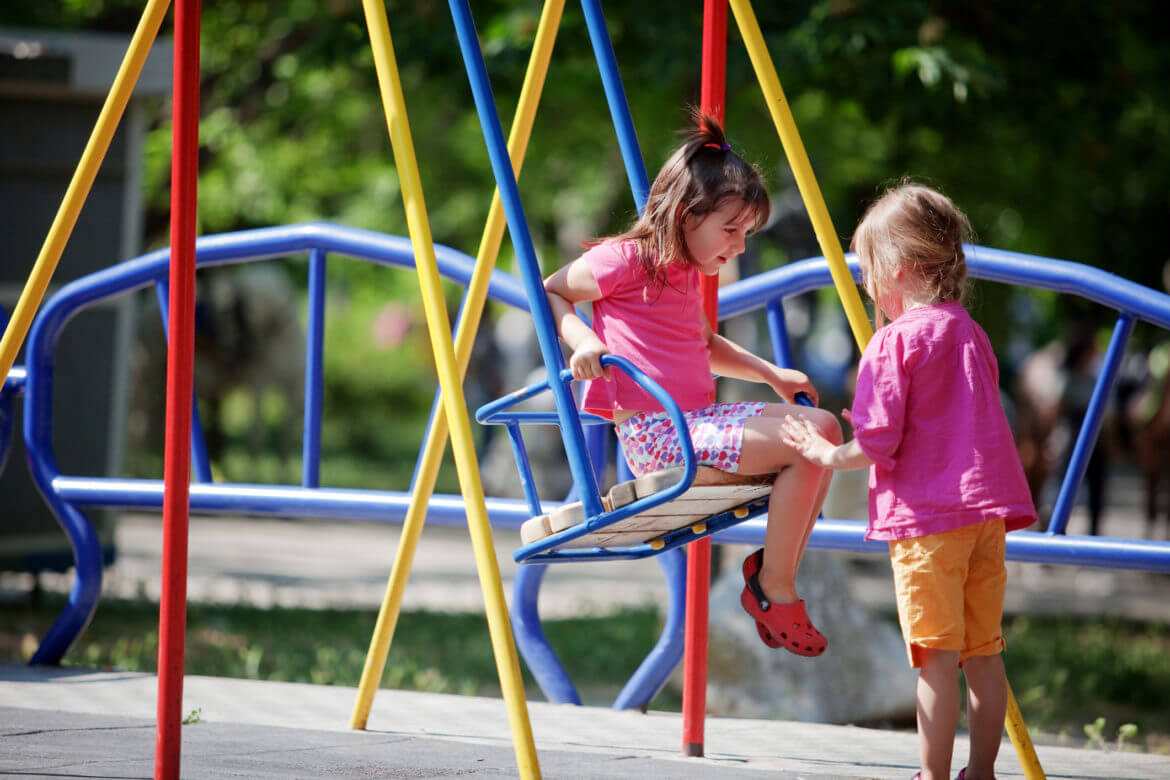Risks in Playgrounds: Possible Benefits for a Child's Well-Being

Playgrounds are controlled areas where children can have a good time. Of course, there are certain risks in playgrounds, but could these risks actually be beneficial in some way to our children?
Among the many advantages of playgrounds, having fun and playing are among the main ones. This is an ideal formula for children to learn and develop correctly.
Playful activities help children develop properly. However, these activities must be safe. But are we, perhaps, bordering on the pathological or obsessive when it comes to our youngsters’ safety and the risks in playgrounds?
While it may be excessive to speak of pathology or obsession, it’s true that many parents go too far in this regard. In addition, by imposing these levels of control, we actually create more obstacles for children and can prevent them from reaching their full potential.

Risks in playgrounds
Be that as it may, the data shows that, despite the fact that playgrounds are getting safer each day, accident statistics are relatively high. How do you combat this? Some experts reaffirm the usefulness of reincorporating risk into certain leisure activities. But why is this a good thing?
The European Injury Database states that, in the European Union, they’ve recorded some 137,000 visits to hospital emergency departments in a year for different types of playground accidents. While head injuries are decreasing, limb fractures remain high, accounting for 30% of all accidents.
Based on these conclusions, we can see that there are certain risks in playgrounds that we need to take into account. Even if experts design and maintain these areas in optimal conditions, an accident such as a clothing snag on a swing, for example, is quite common.
But these aren’t isolated mishaps. If we analyze the situation, we’ll see that there are other factors involved that we may have never taken into account. One of these is a false feeling of total security.
The false sense of security in today’s playgrounds
Could it be the case that children, with so many safety measures in place, suffer from overconfidence? Experts have put forward this hypothesis. They’ve stated that, with all the safety measures in place, children aren’t fully aware of the dangers around them. As a result, they become careless.
Experts claim that they’ve eliminated all risks. However, this isn’t the case. In reality, what we’re encouraging here are attitudes in children that are actually posing a risk for them. For this reason, more and more psychologists are saying that children need to always be alert to the dangers that their activities may entail.

The need to be alert to danger
Based on an evolutionary vision, psychologists such as Peter Gray defend the benefits of playing potentially dangerous games to a certain extent. They argue that, even though they may appear risky, the likelihood of serious injury is actually very low.
Extrapolated to the human species, we can use the example of free play. In these practices, children receive prior instructions and reasonable supervision so that they can become the protagonists of the playful experience. They’ll take part in jumping, rolling, climbing, and exploring.
All this improves the child’s social skills and, as a result, their health. That’s why more and more experts are saying that adventure playgrounds are very useful for our children.
In some countries, they’re already developing the concept of the adventure playground. Especially in the Anglo-Saxon area, in countries such as Canada or Australia, they’ve even banned access to these enclosures for parents.
Only children are allowed to enter, but they’re looked after by workers with very specific and exhaustive training and preparation to monitor, and, if necessary, act, if they detect really dangerous behavior that could put the children’s well-being at risk.
These activities in the playground environment take place in areas that may appear risky. There’ll be scrap metal, wood, ropes, and tools. However, the idea is that the child plays and explores in an area of controlled risk where they can learn, investigate, and get to know first-hand what the real risks are.
In this way, we can train children to pay attention to what they’re doing. They’ll get to know the real risks involved in their actions.
Playgrounds are controlled areas where children can have a good time. Of course, there are certain risks in playgrounds, but could these risks actually be beneficial in some way to our children?
Among the many advantages of playgrounds, having fun and playing are among the main ones. This is an ideal formula for children to learn and develop correctly.
Playful activities help children develop properly. However, these activities must be safe. But are we, perhaps, bordering on the pathological or obsessive when it comes to our youngsters’ safety and the risks in playgrounds?
While it may be excessive to speak of pathology or obsession, it’s true that many parents go too far in this regard. In addition, by imposing these levels of control, we actually create more obstacles for children and can prevent them from reaching their full potential.

Risks in playgrounds
Be that as it may, the data shows that, despite the fact that playgrounds are getting safer each day, accident statistics are relatively high. How do you combat this? Some experts reaffirm the usefulness of reincorporating risk into certain leisure activities. But why is this a good thing?
The European Injury Database states that, in the European Union, they’ve recorded some 137,000 visits to hospital emergency departments in a year for different types of playground accidents. While head injuries are decreasing, limb fractures remain high, accounting for 30% of all accidents.
Based on these conclusions, we can see that there are certain risks in playgrounds that we need to take into account. Even if experts design and maintain these areas in optimal conditions, an accident such as a clothing snag on a swing, for example, is quite common.
But these aren’t isolated mishaps. If we analyze the situation, we’ll see that there are other factors involved that we may have never taken into account. One of these is a false feeling of total security.
The false sense of security in today’s playgrounds
Could it be the case that children, with so many safety measures in place, suffer from overconfidence? Experts have put forward this hypothesis. They’ve stated that, with all the safety measures in place, children aren’t fully aware of the dangers around them. As a result, they become careless.
Experts claim that they’ve eliminated all risks. However, this isn’t the case. In reality, what we’re encouraging here are attitudes in children that are actually posing a risk for them. For this reason, more and more psychologists are saying that children need to always be alert to the dangers that their activities may entail.

The need to be alert to danger
Based on an evolutionary vision, psychologists such as Peter Gray defend the benefits of playing potentially dangerous games to a certain extent. They argue that, even though they may appear risky, the likelihood of serious injury is actually very low.
Extrapolated to the human species, we can use the example of free play. In these practices, children receive prior instructions and reasonable supervision so that they can become the protagonists of the playful experience. They’ll take part in jumping, rolling, climbing, and exploring.
All this improves the child’s social skills and, as a result, their health. That’s why more and more experts are saying that adventure playgrounds are very useful for our children.
In some countries, they’re already developing the concept of the adventure playground. Especially in the Anglo-Saxon area, in countries such as Canada or Australia, they’ve even banned access to these enclosures for parents.
Only children are allowed to enter, but they’re looked after by workers with very specific and exhaustive training and preparation to monitor, and, if necessary, act, if they detect really dangerous behavior that could put the children’s well-being at risk.
These activities in the playground environment take place in areas that may appear risky. There’ll be scrap metal, wood, ropes, and tools. However, the idea is that the child plays and explores in an area of controlled risk where they can learn, investigate, and get to know first-hand what the real risks are.
In this way, we can train children to pay attention to what they’re doing. They’ll get to know the real risks involved in their actions.
This text is provided for informational purposes only and does not replace consultation with a professional. If in doubt, consult your specialist.








